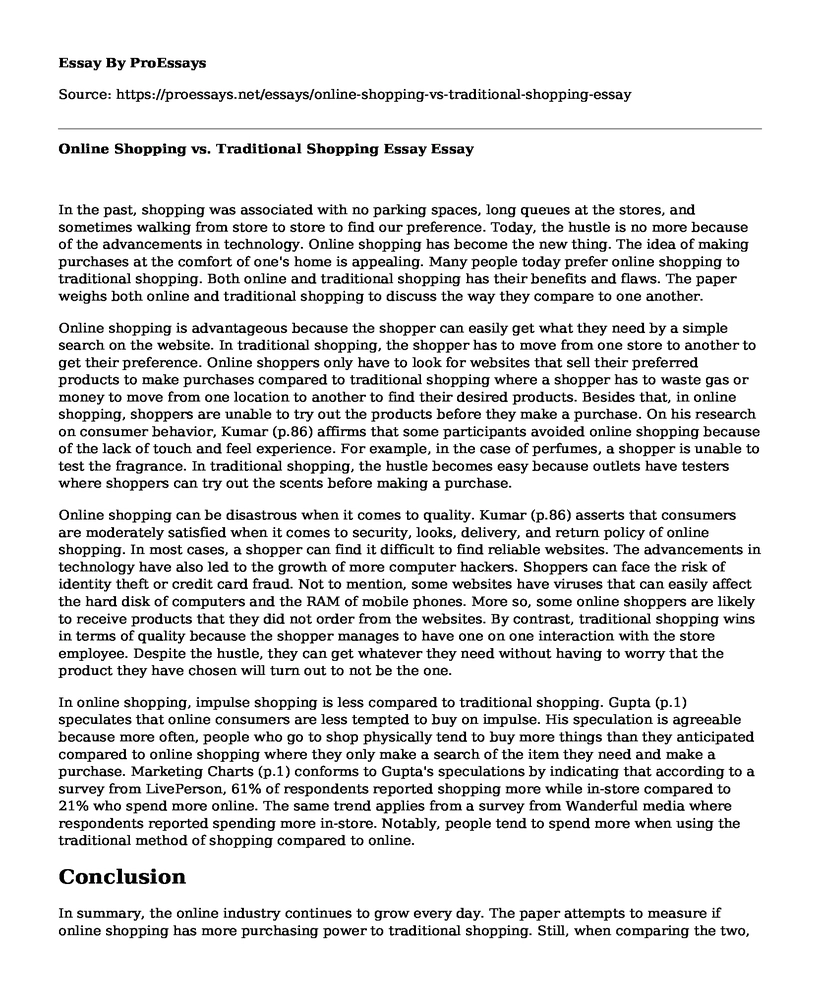In the past, shopping was associated with no parking spaces, long queues at the stores, and sometimes walking from store to store to find our preference. Today, the hustle is no more because of the advancements in technology. Online shopping has become the new thing. The idea of making purchases at the comfort of one's home is appealing. Many people today prefer online shopping to traditional shopping. Both online and traditional shopping has their benefits and flaws. The paper weighs both online and traditional shopping to discuss the way they compare to one another.
Online shopping is advantageous because the shopper can easily get what they need by a simple search on the website. In traditional shopping, the shopper has to move from one store to another to get their preference. Online shoppers only have to look for websites that sell their preferred products to make purchases compared to traditional shopping where a shopper has to waste gas or money to move from one location to another to find their desired products. Besides that, in online shopping, shoppers are unable to try out the products before they make a purchase. On his research on consumer behavior, Kumar (p.86) affirms that some participants avoided online shopping because of the lack of touch and feel experience. For example, in the case of perfumes, a shopper is unable to test the fragrance. In traditional shopping, the hustle becomes easy because outlets have testers where shoppers can try out the scents before making a purchase.
Online shopping can be disastrous when it comes to quality. Kumar (p.86) asserts that consumers are moderately satisfied when it comes to security, looks, delivery, and return policy of online shopping. In most cases, a shopper can find it difficult to find reliable websites. The advancements in technology have also led to the growth of more computer hackers. Shoppers can face the risk of identity theft or credit card fraud. Not to mention, some websites have viruses that can easily affect the hard disk of computers and the RAM of mobile phones. More so, some online shoppers are likely to receive products that they did not order from the websites. By contrast, traditional shopping wins in terms of quality because the shopper manages to have one on one interaction with the store employee. Despite the hustle, they can get whatever they need without having to worry that the product they have chosen will turn out to not be the one.
In online shopping, impulse shopping is less compared to traditional shopping. Gupta (p.1) speculates that online consumers are less tempted to buy on impulse. His speculation is agreeable because more often, people who go to shop physically tend to buy more things than they anticipated compared to online shopping where they only make a search of the item they need and make a purchase. Marketing Charts (p.1) conforms to Gupta's speculations by indicating that according to a survey from LivePerson, 61% of respondents reported shopping more while in-store compared to 21% who spend more online. The same trend applies from a survey from Wanderful media where respondents reported spending more in-store. Notably, people tend to spend more when using the traditional method of shopping compared to online.
Conclusion
In summary, the online industry continues to grow every day. The paper attempts to measure if online shopping has more purchasing power to traditional shopping. Still, when comparing the two, the concept of preference has to be discussed because some people desire online shopping while others prefer traditional shopping. Despite that, people should understand that the two methods of shopping have their pros and cons. All in all, shoppers have to use both methods of shopping at their comfort to lift their experience and make them become more knowledgeable about the two methods.
Works Cited
Gupta, Pranjal. "Shopping Impulses, Online vs. Off." The New York Times. 2011. Accessible at
https://www.nytimes.com/roomfordebate/2011/12/01/save-america-shop-at-work/shopping-impulses-online-vs-off
Kumar, Anapa, Naveen. "Consumer Behavior on Traditional and Online Shopping."International Journal of Engineering, Management & Sciences (IJEMS) ISSN-2348 -3733, Volume-2, Issue-5. 2015.
Marketing Charts. "Online Shoppers Spend More, Impulse Buy More Frequently In-Store."
2013. Accessible at https://www.marketingcharts.com/industries/retail-and-e-commerce-26591
Cite this page
Online Shopping vs. Traditional Shopping Essay. (2022, May 09). Retrieved from https://proessays.net/essays/online-shopping-vs-traditional-shopping-essay
If you are the original author of this essay and no longer wish to have it published on the ProEssays website, please click below to request its removal:
- Public Relations in the Global Environment Essay
- Paper Example on Managing Operations And Supply Chain
- The Reasons Why Employees Join Unions Essay Example
- Essay Example on Stop Smoking: Poster Encourages Ethical Behavior and Prevention
- Essay on Knowledge Base Management: Challenges to Organizational Management
- Denial of Service Attacks: Types & Impact - Essay Sample
- Joint Commission Accreditation: Strengthening Patient Safety & Organizational Growth - Essay Sample







